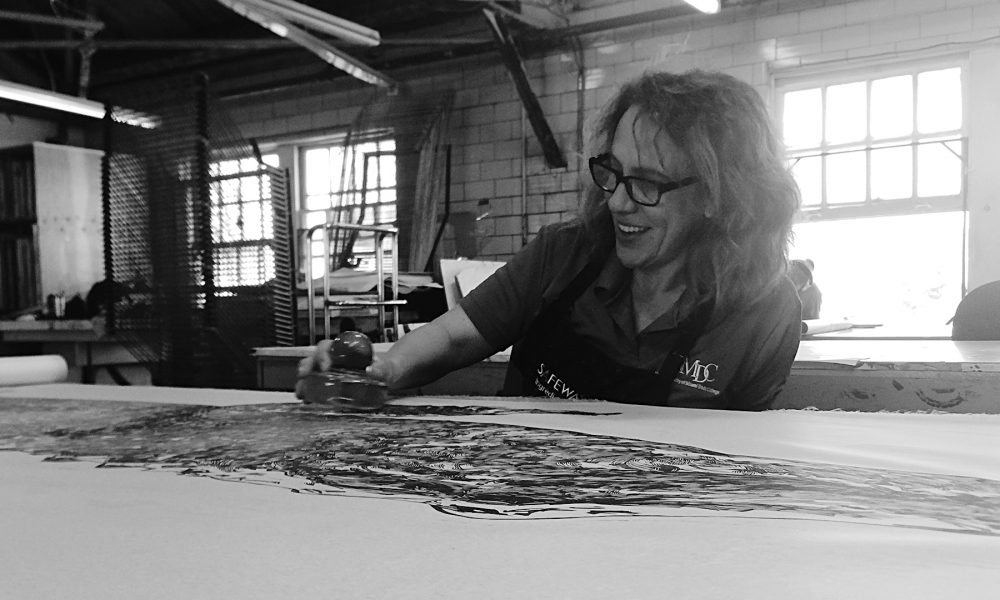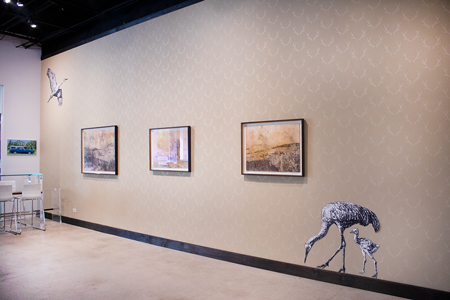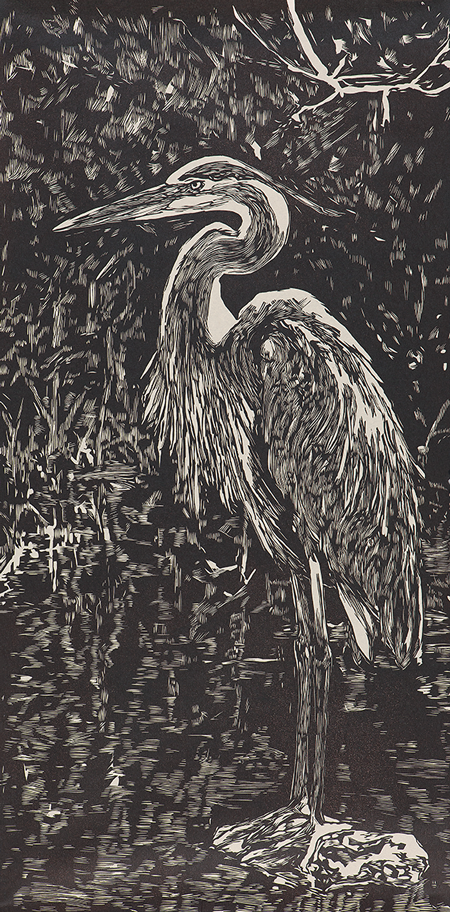“Whenever someone asks you if you can do it, you just say yes and figure it out.”
Jennifer Basile
STUDENT BIO

Monica Barletta is a sophomore in the Honors College at Florida International University. She is currently a Biology major on the Pre-med track and hopes to attend the Herbert Wertheim College of Medicine. Outside of school, she enjoys creating art and spending time with her friends and family.
BIOGRAPHY

Jennifer Basile is a Miami-based landscape artist specializing in printmaking and professor at Miami Dade College. She likes to focus on the landscape because of how important it is to her not just now, but throughout her childhood where she would use it as a way to escape. Basile was born and raised in Queens, New York and eventually moved to Long Island by the time she reached schooling age. She got to see both sides of New York as she described the neighborhood she grew up in as the average suburb where she would spend the weekdays and then go back to urban Queens to visit her grandmother on the weekends. She had a well-rounded education and her first source for inspiration was her junior high art teacher who introduced her to the AP art teacher, which motivated her to take more art classes. She recounted how one of her high school teachers had a program in which the upper-class students would teach the freshmen and sophomores. So, from the start, Basile was inspired to not only pursue art from a very young age, but to teach as well.
In 1991, Basile moved to Florida despite receiving offers for many scholarships from prestigious art schools in New York. As much as she wanted to go to these schools, her parents made it clear to her that they would not support her decision to stay, being 18 and afraid, she agreed to move with them to Davie. There, she started going to Broward Community College and threw herself into her work. She was recognized by her hard work by her teacher and had the opportunity to work as an apprentice for the famous sculpture, Dwayne Hanson. She worked under him for 2 years during which she learned a lot about art and he taught her many valuable life lessons there as well.
After 2 years at Broward, she applied for the University of Miami which she was able to go to because of the scholarships they offered her. Initially at UM, she began as a ceramics and painting major, but after studying under Christine Federighi, she realized she no longer enjoyed doing ceramics. One of her professors recommended trying out printmaking based on the way she did paintings, which she immediately fell in love with, prompting her to stay an extra year and change her major to printmaking and painting.
In 1996, Basile began attending Southern Illinois University for printmaking and painting. She was interested in becoming a teacher and was afraid that just doing printmaking would limit her opportunities to get a teaching job after she would graduate, so she decided to use her elective credit hours for painting. After graduating in 1999, she applied all over Illinois but could not come up with any job except adjunct work. She decided to move to Miami where she began adjunct teaching at the University of Miami and Broward community college and doing work at the Lowe Art Museum and PAMM. Three years later, she got an official position at Miami Dade Community College where she went through a sticky point as she started teaching, where her art production slowed down with being so busy jumping through the hoops of academic life. Once receiving tenure, she applied to the Bakehouse Art Complex where she stayed for 7 years, which ultimately led to her getting signed at the LNS gallery.
PERSONAL IDENTITY
During my interview with Jennifer Basile, she mentioned many stories from her past that helped shape her into the person she is today. Basile has immigrant grandparents on both sides and her parents are American born and raised but are still of Italian heritage. Although she grew up in America, she spent a lot of time with her grandparents having Italian tendencies. She recalled that she would go to school with classic Italian lunches that were completely normal to her but very weird to other kids. Not only would she get picked on for being different, but she described herself as “the nerdy chubby kid” that made the bullying even worse. In high school, this was brought an end in a school fight after a girl picked on her in the cafeteria and she finally decided she had had enough of being run over by other people.
This had a huge parallel with an experience later in her life that had a huge impact in shaping her as an artist. Threatened by her abilities, the printmaking professor at the university she taught at would not allow her to use the lab. This was heartbreaking because without the lab it would be very difficult to create the prints she was passionate about. Just like how she dealt with the bully in high school, she decided she would not take this and decided to spite him by making a print for the faculty show they would both be in. She made a huge print that was 8 feet tall and 20 feet long which she made by hand at the bakehouse. This was extremely significant in her life because it was his determination to keep her away from printmaking that drove her deeper into it. This was how she introduced herself into the art world as a printmaker, and from that point forward she continued making these large prints that is now considered one of her specialties.
Her schooling also plays a huge part in her work, especially from her undergraduate career. She mentioned that the University of Miami placed a huge emphasis on the aesthetic beauty of the piece as opposed to the message it is sending. This has manifested itself in her work because she omits things that are not aesthetically pleasing from her art, like garbage, that some other artists probably would have included to raise awareness about pollution, rather she focuses on the beauty of her work to draw people in so she can have conversations with them about the issues at hand.
CULTURAL IDENTITY

Living in Miami since a young age, its cultural influences can be seen in Basile’s work as a lot of it is based on the Everglades landscape and the animals that can be found there. Her work is influenced by the artist, Swoon who makes a lot of immersive installations and is very well-known for her large prints. Basile want those who view her art to feel as though they are experiencing these landscapes the way she does and allow them to escape reality in order to inspire them to preserve its natural beauty through her huge prints. She cares deeply about our parks and wants to capture the beauty of the environment before it is changed by human activities.
SUBJECT OF ARTWORK
Passionate about climate change and deathly afraid of what humans are doing to the environment, all of Basile’s work is inspired by the landscape. She believes that we are behind in our efforts to combat climate change and that this is an issue everyone should be concerned about. She often tells people that “science is not a liberal conspiracy theory, if the science is telling us something is going to happen then we should listen.”
Due to the fact that certain landscapes are rapidly changing from being destroyed, Basile sees it as a race to get out there and document it. She does this by hiking, kayaking, and camping in national and state parks throughout the United States. She enjoys going on very long hikes that the average American usually would not do, which allows her to see a lot of untouched beauty which she works into her artwork. During these adventures, Basile will heavily photograph her journey and take anywhere from 300 to 400 photographs, of which she will spend the next week weeding through to find the pictures that perfectly emulate the space she was in and highlight the natural beauty of the area.
Her work is quite successful in bringing about awareness to the issue of climate change, but not in the “beat you over the head” with these issues’ kind-of-way that most other environmentalist artists would use. Instead, she uses a different approach in which she just strives to bring about conversation with her pieces in the same way that we were having a discussion about these issues during this interview.
Basile does accomplish this task well as she connects to people through her art, but she does not think her art alone would project this viewpoint of hers. She has never been interested in making landscape artwork based on things that we actually see like some artists do when they want to make a point about how trash is ruining the beauty of the environment. Instead, she will omit these details in her pieces to focus more on the aesthetic beauty of the landscape.
Basile does not want people to look at her work and think it’s the work of an environmentalist, but the work of a landscape artist. She does not want to hammer the message into people but rather wants to give the person looking at the artwork room to bring their own ideas and thoughts to it. The art works to strike conversations so she can mention the problems in real life conversations, which she believes works better than just forcing one to see things in the same light she does.
FORMAL ELEMENTS OF ARTWORK
When I asked about her creative process, she mentioned that this process includes both planned out and calculated methods in some aspects, but she is a little more spontaneous in other areas. As mentioned before, her process includes going to parks, taking many pictures, and then sorting through those pictures until she finds the one that perfectly captures the beauty of the area. She takes this image and makes a drawing onto linoleum or a woodblock using graffiti markers. Using the graffiti markers is purposeful in her work because she likes to highlight the mark making, not just the imagery and importance of landscape, but how the marks are being made.
During her process, she will delete, omit, add things, and change it up a little. While most printmakers will take the image and put it exactly the way it is and cut it that way, she has painter tendencies where she changes her mind frequently throughout the process. This is why she says it is both very planned out and spontaneous at the same time, because she often changes her mind as she draws or even as she is cutting the block.
EXHIBITION AND PROJECT HISTORY

Jennifer Basile has exhibited her work in many places: the LnS gallery, Art Basel, Deering Estate, the Bakehouse Art Complex just to name a few. Of those places that have exhibited her work the most important was at the Bakehouse Art Complex, where she met the owner Bernice Steinbaum who she wanted to get in front of for years. She was so nervous to show Steinbaum her work, but when they finally met, Basile recalls that she looked at her and then the huge print she was working on and told Basile that nobody else in Miami is doing what she is and encouraged her to continue her monochromatic work. As they got to know each other better, Steinbaum began to exhibit her work with other artists and even invited her to do an installation in her own home. She was so nervous and did not even know if she could accomplish it, but told me she said yes because, “whenever someone asks you if you can do it, you just say yes and figure it out.” This installation was very important in her career as it led to her getting signed at the LnS gallery after the owners of the gallery were blown away by that piece.
STUDENT PERSPECTIVE

“Stanley” the Great Blue Heron, 2018 relief print on rice paper edition 1 of 1 (+ 1 AP) 24 x 48 inches Images courtesy of Jennifer Basile and LnS Gallery.
I chose Jennifer Basile as the center for my project after researching local South Florida artists and falling in love with her work and the message she was spreading through her art. Her art prints immediately caught my attention with their beauty, and I felt like they transported me to the landscapes which she based her pieces off of.
One of the things that drew me to her work was that I love how her art is based entirely on the landscape in order to bring attention to the problems that these parks are facing. I thought the way she uses a different approach than most other artists trying to bring awareness was interesting, by wanting viewers to derive their own feelings and connectivity to the piece rather than having the art direct your thoughts. After thinking about what she said for a while I realized that this method unconsciously worked for me as well, because by falling in love with the work and making my own connection to it, it did get me to worry more about the problems our park is facing and wonder how I can help. When she was discussing how the garbage was ruining our parks, it got me to care more about it as opposed to if someone was trying to hammer the idea into me and force me to care about it.
Sources
Jennifer_basile. (2021, February 20). Retrieved April 25, 2021, from https://lnsgallery.com/jennifer_basile/
Jennifer_basile. (2021, February 20). Retrieved April 25, 2021, from https://lnsgallery.com/jennifer_basile/#artist_information









































































